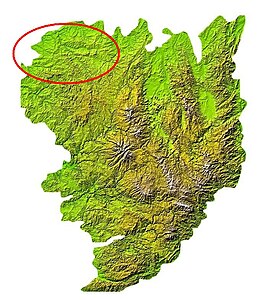Monts de la Marche
| Monts de la Marche | |
|---|---|
|
Location of the Monts de la Marche in the Massif Central |
|
|
The sea of rocks at Maupuy in the Monts de Guéret |
|
| Highest peak | Puy de Sauvagnac ( 701 m ) |
| location | Charente , department Cher , Creuse , Haute-Vienne department and the department of Indre (central France ) |
| part of | Massif Central |
| Coordinates | 46 ° 1 ' N , 1 ° 27' E |
| rock | Mica slate, gneiss, granite |
The Monts de la Marche are a natural region in the north of the Monts du Limousin in the northwest corner of the French Massif Central .
etymology
The Monts de la Marche were named after the county of Marche .
geography
The Monts de la Marche are mainly located in the Creuse and Haute-Vienne ( Nouvelle-Aquitaine region ), but still touch the northern edge of the Charente department and the south of the Cher and Indre departments . You are surrounded by the following natural regions:
- in the north of Boischaut Sud
- to the east of the Combraille
- in the southeast of the Plateau de Millevaches
- in the south of Plateau du Limousin , which is of the Monts du Limousin - especially the Monts de Chalus and the Monts de Fayat delimiting -
- to the west of the Charente limousine or the Confolentais .
Their relief consists of clear mountain ranges, which are separated from each other by low-lying valleys or even gorges.
In principle, the following larger individual massifs can be distinguished in the Monts de la Marche:
- the Monts de Blond
- the Monts d'Ambazac
- the Monts de Guéret
- the Monts de Toulx-Sainte-Croix
Hydrography
The Monts de la Marche are drained by important receiving waters towards the Vienne , which in turn flows into the Loire :
- from the catchment area of the Creuse flowing to the northwest in the northeast section
- from the catchment area of the Gartempe in the central and north-west section
- from the catchment area of the Taurion in the southeast section
- from the catchment area of the Glane in the southern section.
The south-west and west drains directly over the Vienne.
geology

Geologically, the Monts de la Marche belong to the crystalline basement of the Massif Central . They submerge on their northern edge under the Mesozoic sediments of the Paris Basin , in the west they are covered by the Mesozoic of the Seuil du Poitou and the northern Aquitaine Basin . Their structural geological structure is quite complex, as they consist of a presumed autochthon and two flat ceiling systems. Upcoming are mica slate , paragneiss and orthogneiss , migmatite , leuco granite and granite . Structurally geologically, the basal parautochthonous mica slate unit and the lower and upper gneiss cover of the Limousin are present. These three tectonic units were intruded by very different granitoids during and towards the end of the Variscan Orogeny.
The Monts de la Marche are separated into two halves by the more or less east-west trending Boussac Fault (which splits into the Marche Shear Zone running a little further south - both left-sided lateral shifts ), which show a very different structure . The southern section is in turn subdivided again by the Nantiat Fault - a significant, curved, north-northeast to northeast trending, westward-directed fault - into a western and an eastern section. In the northern half - the Plateau d'Aigurande - the structures run east-west, whereas in the western southern section they are generally adjusted in the south-east-north-west direction and thus extend the conditions encountered in the Vendée . To the east of the Nantiat Fault, the leucogranitic Saint-Sylvestre massif appears clumpy in the Monts d'Ambazac. Another significant fault (the Bussière-Madeleine Fault , which pushes eastwards ) runs roughly parallel to the Nantiat Fault and is cut off in the north by the Boussac Fault. On its northern section, the Guéret granite that forms the Monts de Guéret - a huge, flat granite intrusion - has slipped in a south-easterly direction.
climate
The region of the Monts de la Marche is under the influence of an oceanic climate, which is weakened depending on the altitude. The rainfall is abundant. The snowfalls are quite significant and remain on the ground. The winter temperatures are quite low and are governed by the respective altitude.
Flora and fauna
The Monts de la Marche are covered by a relatively dense bocage vegetation. Meadows and pastures allow animals to be kept, with mixed cultures contributing to the animal feed. The dividing hedges consist of English oak , chestnut , European beech , ash , blackthorn , privet , common spindle , blackberry , hazel and hornbeam . In the lowlands, however, elderberry and white willow usually appear .
economy
Agriculture in the Monts de la Marche is dominated by cattle and sheep breeding.

